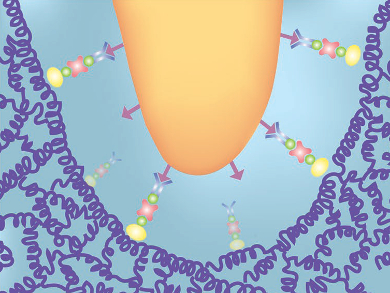Biointerfaces, the surfaces between living cells and other materials, are important for applications in, e.g., biomedicine and tissue engineering. The properties of such surfaces can be tuned by controlling either their chemical nature or their topography. However, the simultaneous control of both has not been extensively investigated.
Shutao Wang, Chinese Academy of Sciences, Beijing, and colleagues have developed hydrogel coatings that can capture and release cancer cells. The team prepared the hydrogel by co-polymerizing N-isopropylacrylamide (NIPAAm) and N,N′-methylenebisacrylamide (NNMBA) in the presence of ammonium persulfate (APS) as an initiator and tetramethylethylenediamine (TEMED) as an accelerator. Then the gel’s surface was modified using biotinylated bovine serum albumin (biotin-BSA), a hydrophobic protein. This protein was linked to biotinylated epithelial-cell adhesion-molecule antibodies (anti-EpCAM), which can bind human breast cancer cells.
The hydrogel can capture cancer cells at 37 °C, since its surface “collapses” and develops nanowrinkles, which improve cell adhesion by providing a larger contact area (pictured). At room temperature (< 25 °C), the polymer chains stretch, the wrinkles disappear, the surface becomes hydrophilic, and the interaction between biotin-BSA and the hydrogel is broken. Thus, the cells are released.
According to the researchers, this approach, which uses the simultaneous tuning of surface hydrophobicity and topography, could provide a platform for tumor detection in vitro. The process causes little damage to the cells, which benefits subsequent cell cultures.
- Smart Thin Hydrogel Coatings Harnessing Hydrophobicity and Topography to Capture and Release Cancer Cells,
Luying Wang, Hongliang Liu, Feilong Zhang, Guannan Li, Shutao Wang,
Small 2016.
DOI: 10.1002/smll.201601275




